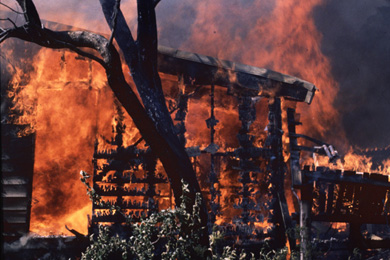Heat, fire, and fear in Australia
Nov 18, 2009 - by Staff
Nov 18, 2009 - by Staff
Bob Henson | 18 November 2009 • This week, parts of South Australia found themselves under the nation’s first-ever warning of “catastrophic” fire danger. The new topmost category—ranking above “severe” and “extreme” risk—was introduced by the Australian Bureau of Meteorology (BOM) in the aftermath of Black Saturday (7 February 2009). On that horrific day, massive bushfires killed 173 Australians and traumatized countless others. According to a report by the Victorian Bushfires Royal Commission, “The plume of the fires created a convection effect that generated winds so strong that trees appeared to have been screwed from the ground.”
 Bushfires are a perennial threat in the Dandenongs region, east of Melbourne. (Courtesy CSIRO.)
Bushfires are a perennial threat in the Dandenongs region, east of Melbourne. (Courtesy CSIRO.)
Could disaster strike again? The premier of New South Wales warned in October that 2009–2010 may be “the highest risk summer that we have ever faced.”
The preconditions for the upcoming austral summer are indeed as bad, if not worse, than last year’s. El Niño, which has strengthened in recent weeks (NOAA analysis, PDF), is correlated with drought and summer heat over much of the continent.
Several weeks ago, millions around the world saw a tangible sign of ongoing drought in photos of the thick pall of dust that swaddled Sydney on 23 September. It gave the sky a surreal reddish cast and pared visibilities in some areas to less than 0.5 kilometer (0.3 mile, or about four city blocks). Air quality was the worst on record.
It’s been not only very dry in much of Australia, but also very warm. Even in midwinter, temperatures soared: August ran further above average than any other month in Australian history (BOM statement, PDF). Readings in early November broke many records across the nation’s southern half.
The BOM’s latest seasonal forecast (November to January) points toward high odds of above-average temperatures and below-average precipitation for southeast Australia, the country’s most populous region. Much of this area has been short on rainfall for more than a decade, and water worries are so intense that Victoria has embarked on building the nation’s largest desalination plant.
Nice weather, when you can get it
The big coastal cities of the southeast—Sydney, Melbourne, and Adelaide—tend to see periods of blowtorch heat separated by strings of much more pleasant weather, not unlike California’s coastal climate. North and northwest winds can push cool ocean air offshore, replacing it with dry, hot air that sends temperatures soaring to 35°C (95°F) and beyond. Suffer through five days of this, and you’re in a heat wave, according to one common definition. Recently, on 8–15 November, Adelaide endured eight days in a row above 35°C. It was the city’s first springtime heat wave on record.
 Greg Holland, interim director of the NCAR Earth System Laboratory, took this photo of a Black Saturday fire that threatened his son's farm near Healesville, about 80 km (50 mi) northeast of Melbourne.
Greg Holland, interim director of the NCAR Earth System Laboratory, took this photo of a Black Saturday fire that threatened his son's farm near Healesville, about 80 km (50 mi) northeast of Melbourne.
Deadly heat
Heat waves themselves may claim even more victims in Australia than the bushfires they help to stoke. Longtime BOM climatologist Neville Nicholls, now at Monash University, analyzed death notices and found a 45 percent jump in fatalities during the heat wave of late January 2009 across southeastern Australia. That would equate to roughly 200 deaths beyond those otherwise expected. The state of Victoria issued estimates that were even more grim—close to 400 extra deaths in a similar period.
Few other parts of the world are showing climatic trends as distinct and ominous as Australia’s—and these changes are broadly consistent with what climate models tell us the 21st century has in store for the continent. As the southern jet stream contracts toward Antarctica, rainfall is expected to decrease across much of the continent, and temperatures will continue to rise.
Among the canaries in the coal mine of climate change, it might be time to include an Aussie.
Many thanks to Paul Holper (CSIRO Marine and Atmospheric Research) for background material and fact checking.